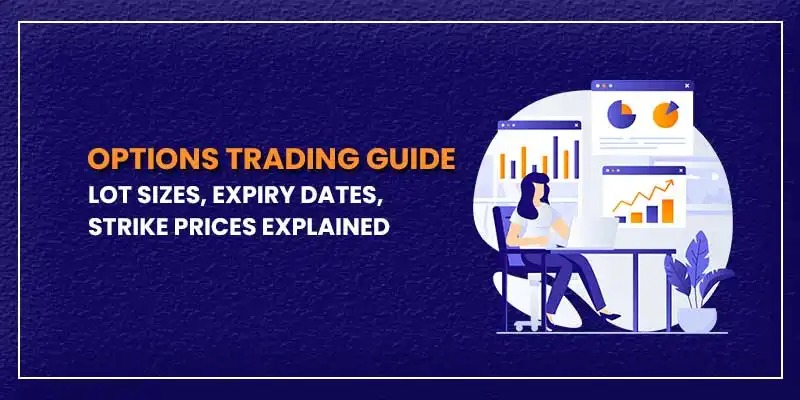Some essential components of options trading, such as lot sizes, expiry dates, and strike prices, play a crucial role in shaping an option contract and determining its risk and reward potential. This blog details these parts, clarifying their jobs and how they work together in the trading system.
Contents
- Lot Sizes
- Expiry
- Strike Prices
- Conclusion
- FAQs
Lot Sizes
In options trading, the “lot size” refers to the standard quantity of the underlying asset represented by one option contract. The exchange predetermines this lot size, and it remains fixed for each contract type. Understanding the lot size is important because:
- Contract Value: Lot size helps in determining the total contract value and the required capital.
- Risk Management: It helps traders manage their exposure, as each contract represents a specific number of shares or units.
- Position Sizing: Lot size allows traders to plan their position size based on their risk appetite and portfolio strategy.
It is essential for traders always to check the lot size for each option contract, as it can be different for various underlying assets and platforms.
Read Also: Things to Know Before Trading in Futures and Options
Expiry
The expiry date is the predetermined date on which an option contract becomes invalid. It is an essential factor in options trading because:
- Time Value: Options lose value as they approach expiry, affecting premiums.
- Strategic Planning: Traders select expiry dates based on their trading strategy and market outlook.
- Flexibility: Options have various expiry cycles — weekly, monthly, or quarterly — allowing traders to plan their trades accordingly.
- Settlement: At expiry, options that are in-the-money are settled, while those out-of-the-money expire worthless.
Knowing a lot about how expiry works can help you avoid losing too much money through time decay and plan when to get out of positions or roll them over.
Strike Prices
You can buy (call option) or sell (put option) the underlying asset at a set price (the strike price) when you exercise your option. The strike price is the fixed price at which the holder of an option can buy (call) or sell (put) the underlying asset. It plays a crucial role in:
- Profitability Assessment: Determines if an option is in-the-money, at-the-money, or out-of-the-money.
- Premium Determination: Options with strike prices closer to the market price usually have higher premiums due to a greater probability of being profitable.
- Strategic Selection: Traders choose strike prices based on market outlook, risk appetite, and desired exposure.
Read Also: Beginner’s Guide to Understanding Mutual Fund Investments
Conclusion
A sound options trading strategy requires a thorough understanding of lot sizes, expiry dates, and strike prices. These components influence trade outcomes and risk levels. By being aware of these factors, traders can make informed decisions and manage their trading positions effectively.
Disclaimer: This content is purely for informational purposes and is not intended as investment advice. Options trading involves substantial risk and is not suitable for all investors. Please read the Risk Disclosure Documents and consult your financial advisor before making any trading decisions. Past performance is not indicative of future results.
FAQs
The liquidity of an options contract depends on factors such as trading volume, bid-ask spread, and the interest in the underlying asset.
Implied volatility impacts option premiums and risk assessment. Higher volatility generally leads to higher premiums.
Margin requirements determine the capital needed to maintain positions, affecting trade size and risk management strategies.

